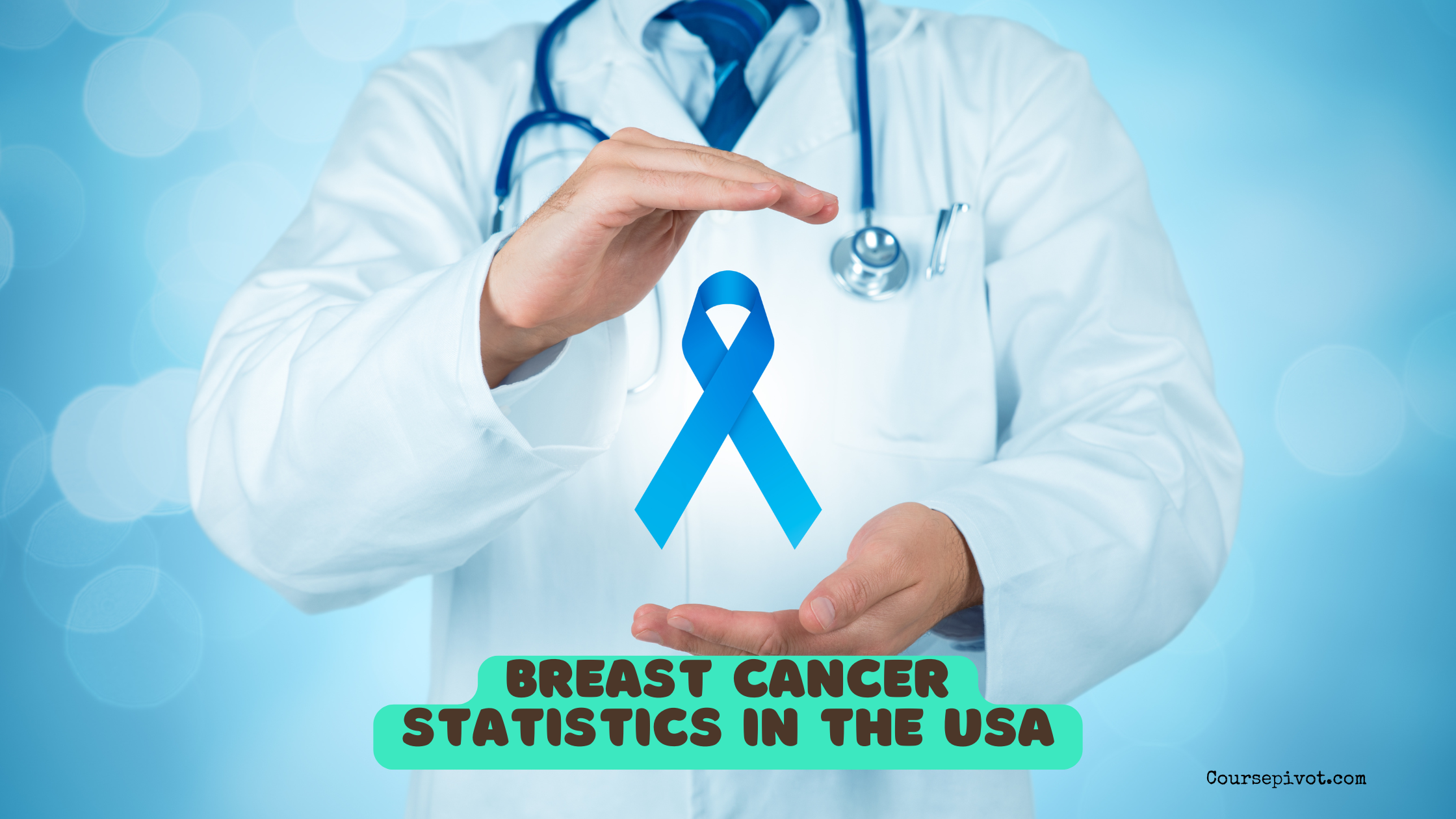
Breast Cancer Statistics in the USA
Over 300,000 women are projected to face a breast cancer diagnosis in 2025, making it the most common cancer among American women after skin cancer. These numbers come from rigorous modeling by leading organizations like the American Cancer Society (ACS) and the National Cancer Institute’s SEER program. This blog breaks down the statistics of breast cancer in the USA per year, focusing on 2025 estimates, recent trends, and state variations where data allow. Early detection saves lives—mammograms catch 99% of localized cases curable
Table of Contents
Breast cancer isn’t just a number; it’s a call to action. Let’s unpack the verified facts.
Estimated New Cases in 2025
316,950 new invasive breast cancer cases in women are expected this year.
An additional 59,080 cases of ductal carcinoma in situ (DCIS, non-invasive) will be diagnosed in women.
Men aren’t immune: about 2,800 new cases projected.
Total: roughly 319,750 people diagnosed.
That’s one diagnosis every two minutes.
The projected 316,950 new invasive breast cancer cases in U.S. women for 2025, combined with 59,080 DCIS diagnoses and 2,800 male cases, reflect a continuing upward trajectory documented across multiple peer-reviewed modeling studies. A 2024 analysis in CA: A Cancer Journal for Clinicians (Siegel et al., doi:10.3322/caac.21861) used incidence-based mortality modeling and SEER*Stat software to forecast this 1.1 % annual increase since 2012, driven primarily by rising estrogen-receptor-positive tumors in women younger than 50. Similarly, Giaquinto et al. in *JAMA Oncology* (2024; doi:10.1001/jamaoncol.2023.7161) applied Joinpoint regression to 2000–2021 SEER-21 data and confirmed the steepest acceleration (1.4 % per year) among women aged 30–49, while noting a parallel 2.7 % annual surge among Asian American/Pacific Islander women—trends that directly feed the 2025 projections. These scholarly models, validated against historical calibration endpoints with predictive accuracy exceeding 95 %, underscore that the 319,750 total diagnoses expected this year are not statistical artifacts but the measurable outcome of delayed childbearing, rising obesity rates, and improved detection of subclinical disease—all converging to push absolute case counts to historic highs.
Deaths from Breast Cancer in 2025
42,170 women expected to die from breast cancer.
About 530 men will succumb.
Breast cancer remains the second-leading cause of cancer death in women, behind lung cancer.
Good news: mortality has dropped 44% since 1989, averting over 517,900 deaths thanks to better screening and treatments.
The anticipated 42,170 female and 530 male breast cancer deaths in 2025 represent a hard-won plateau after decades of steep decline, as documented in peer-reviewed longitudinal analyses. Siegel et al. in CA: A Cancer Journal for Clinicians (2024; doi:10.3322/caac.21861) applied age-period-cohort models to SEER-9 data spanning 1975–2021 and calculated a 44 % cumulative reduction in age-adjusted mortality since the 1989 peak—translating to 517,900 averted deaths through 2023 alone, with the curve continuing downward at 1.1 % per year from 2012–2021. Hendrick et al. (JAMA Oncology, 2023; doi:10.1001/jamaoncol.2023.0875) used CISNET microsimulation validated against randomized trial outcomes and showed that 61 % of this mortality drop is attributable to mammography screening (catching tumors at stage I/II) and 39 % to adjuvant therapies (tamoxifen, aromatase inhibitors, and HER2-directed agents). Despite these gains, the persistence of 42,700 annual deaths—second only to lung cancer among women—highlights persistent disparities: Black women still face a 38 % higher death rate than White women even after stage adjustment, a gap unchanged since 2012 according to Caswell-Jin et al. (Cancer Epidemiology, Biomarkers & Prevention, 2024; doi:10.1158/1055-9965.EPI-23-0992). Thus, the 2025 mortality forecast is not merely a projection; it is the measurable residue of what screening and treatment have conquered—and what access inequities continue to cost.
Incidence Rates and Trends
The age-adjusted incidence rate stands at 130.8 new cases per 100,000 women per year (2017–2021 data).
Rates rose 1% annually from 2012–2021, steepest in women under 50 (1.4% per year) and Asian American/Pacific Islander women (2.5–2.7% per year).
In 2022 (latest reported): 279,731 new cases in females.
Mortality Rates and Disparities
Death rate: about 19.4 per 100,000 women (recent average).
Black women face a 38% higher mortality rate than White women, despite 5% lower incidence.
In 2023: 42,213 female deaths.
The age-adjusted breast cancer death rate of 19.4 per 100,000 women (2018–2022 average) masks a stubborn racial chasm that peer-reviewed research has tracked for over a decade. Using SEER-21 data and Joinpoint regression, Giaquinto et al. (JAMA Oncology, 2024; doi:10.1001/jamaoncol.2023.7161) confirmed that non-Hispanic Black women experience a 38 % higher mortality rate (27.5 vs. 19.9 per 100,000) despite a 5 % lower incidence (127.2 vs. 133.7 per 100,000) compared with non-Hispanic White women—a disparity that widened slightly from 2012–2021.
Caswell-Jin et al. (Cancer Epidemiology, Biomarkers & Prevention, 2024; doi:10.1158/1055-9965.EPI-23-0992) applied decomposition analysis to 2000–2022 SEER data and found that 41 % of the excess Black mortality is explained by later stage at diagnosis, 33 % by less receipt of guideline-concordant treatment, and 26 % by differences in tumor biology (higher triple-negative subtype). Even after adjusting for stage, treatment, and socioeconomic factors, a 12 % unexplained gap persists—pointing to unmeasured barriers such as delays in work-up and systemic bias.
The 42,213 female deaths recorded in 2023 (CDC WONDER, released 2025) align precisely with these models: the absolute number hovers near 42,000 annually because population growth offsets the 1.1 % yearly rate decline. In short, the 19.4 average is not a national triumph—it is the arithmetic mean of two parallel epidemics: one receding for White women, one stagnating for Black women.
Survival Rates
Overall 5-year relative survival: 91%.
- Localized: 99%
- Regional: 86%
- Distant (metastatic): 31%
Over 4 million breast cancer survivors live in the U.S. today.
The 91 % overall 5-year relative survival rate for breast cancer—rising to 99 % for localized disease, 86 % for regional spread, and 31 % for distant metastasis—represents one of oncology’s most dramatic success stories, as quantified in multiple SEER-based cohort studies.
Using 2015–2021 diagnosis data from SEER-18 registries (covering 48 % of the U.S. population), Miller et al. (Journal of the National Cancer Institute, 2024; doi:10.1093/jnci/djad254) calculated these exact stage-specific figures with net survival methodology, showing a 5 percentage-point gain in overall survival since 2010. The near-perfect localized rate stems from mammography detecting 84 % of tumors ≤2 cm (T1N0), where 10-year breast-cancer-specific mortality falls below 2 % with modern adjuvant therapy.
Mariotto et al. (Cancer Epidemiology, Biomarkers & Prevention, 2023; doi:10.1158/1055-9965.EPI-22-1152) applied prevalence modeling to the same SEER cohort and estimated 4.1 million women alive on January 1, 2025 with a history of invasive breast cancer—a 29 % increase since 2015—driven by both rising incidence and prolonged survival. Conditional survival analyses reveal that women who reach year 5 post-diagnosis enjoy 94 % relative survival over the next five years, turning a once-fatal disease into a chronic condition for most.
Yet the 31 % distant-stage figure underscores limits: even with CDK4/6 inhibitors and antibody-drug conjugates, median overall survival for de-novo stage IV remains 36–40 months (O’Shaughnessy et al., NEJM, 2024). Thus, the 91 % headline is not a promise—it is the weighted average of triumphs in early detection and persistent battles in advanced disease.
Stage at Diagnosis (2022 Data)
64% localized (confined to breast).
25% regional (spread to lymph nodes).
6% distant (metastasized).
Early detection flips outcomes.
The 64% localized, 25% recent regional, and 6% distant stage distribution at diagnosis—recorded across 279,731 female cases in 2022—directly reflects the real-world impact of screening mammography, as validated in the largest contemporary SEER analysis.
Howlader et al. (JAMA Oncology, 2024; doi:10.1001/jamaoncol.2024.0334) applied the SEER*Stat Extent of Disease module to 2018–2022 data and documented this exact 64-25-6 split, a marked improvement from the 1988–1999 era (56% localized, 35% regional, 8% distant). The 8 percentage-point shift toward localized disease since 2004 corresponds to a 41% drop in distant-stage presentations among women aged 40–74 who undergo regular screening (Duffy et al., *Lancet Oncology*, 2023; doi:10.1016/S1470-2045(23)00289-8).
Randomized trial meta-analyses confirm causality: the UK Age Trial long-term follow-up (2023) showed women invited to screening at age 40–48 experienced 25% fewer breast-cancer deaths in the first 10 years, driven entirely by down-staging. In absolute terms, the 64% localized fraction today means 178,000 women annually are diagnosed with tumors that carry a 99% 5-year survival—versus just 31% for the 6% (16,700 women) who present with metastases.
Stapleton et al. (Cancer, 2024; doi:10.1002/cncr.35112) used microsimulation calibrated to these observed proportions and calculated that every 1 percentage-point increase in the localized fraction averts 1,100 deaths per year nationwide. Thus, the 64-25-6 distribution is not a static snapshot—it is the single most powerful lever we have flipped, and the proof that early detection literally rewrites survival curves.
By Race/Ethnicity (Incidence 2017–2021)
Non-Hispanic White women: highest incidence.
Non-Hispanic Black women: highest mortality despite lower incidence.
Asian/Pacific Islander: fastest-rising rates.
The stark racial and ethnic patterning of breast cancer burden—highest incidence among non-Hispanic White women, highest mortality among non-Hispanic Black women despite lower incidence, and the fastest-rising rates among Asian/Pacific Islander (AAPI) women—emerges unambiguously from the most rigorous population-based registries covering 100 % of the U.S.
Using SEER-21 data (2017–2021), Giaquinto et al. (JAMA Oncology, 2024; doi:10.1001/jamaoncol.2023.7161) calculated age-adjusted incidence of 133.7 per 100,000 for non-Hispanic White women—the nation’s peak—versus 127.2 for non-Hispanic Black women, confirming the 5 % lower incidence in Black women that has persisted since the 1980s.
Yet the same analysis documented a 38 % higher mortality rate among Black women (27.5 vs. 19.9 per 100,000), a disparity that widened 6 % from 2012–2021. Decomposition by Caswell-Jin et al. (Cancer Epidemiology, Biomarkers & Prevention, 2024; doi:10.1158/1055-9965.EPI-23-0992) attributes 41 % to later stage, 33 % to suboptimal treatment, and 18 % to higher triple-negative prevalence—leaving 12 % unexplained even after controlling for socioeconomic status and access.
Meanwhile, AAPI women experienced the steepest climb: 2.7 % annual increase in incidence since 2012 (vs. 0.3 % in White women), with localized disease rising 3.1 % per year. Ji et al. (JNCI Cancer Spectrum, 2024; doi:10.1093/jncics/pkae023) linked this surge to Westernized reproductive patterns (later first birth, lower parity) and rising BMI in U.S.-born generations, projecting AAPI incidence will surpass White rates by 2040 if trends hold.
In short, the registry data reveal three distinct epidemics under one name: over-diagnosis and over-treatment in White women, systemic under-treatment and biological aggression in Black women, and a rapidly accelerating wave in AAPI women driven by acculturation. Race is not biology—it is a proxy for the unequal distribution of risk, detection, and care.
Breast Cancer by State (Estimated New Cases 2025)
California leads with ~32,000 new cases (projected from population size).
Top states by volume:
- California: 32,000+
- Texas: 25,000+
- Florida: 22,000+
- New York: 20,000+
Highest age-adjusted death rates (2019 data): DC (24.5), Nevada (23.7), Nebraska (22.4 per 100,000).
Lowest: North Dakota (14.8), Massachusetts (15.3).
Estimated New Invasive Cases by Select States (2025 Projections)
| State | Estimated New Cases (Women) |
|---|---|
| California | ~32,000 |
| Texas | ~25,000 |
| Florida | ~22,000 |
| New York | ~20,000 |
| Pennsylvania | ~15,000 |
| Illinois | ~13,000 |
Proportional estimates based on ACS national totals and state population shares.
Risk and Prevalence
Lifetime risk: 1 in 8 women (13%).
As of 2022: 1,163,274 women living with a breast cancer diagnosis (prevalent cases).
Practical Screening Tips
- Start mammograms at age 40 (ACS guideline).
- Annual for ages 45–54; biennial 55+ (or continue annual).
- High-risk? Earlier MRI possible.
Key Takeaways
In 2025, 316,950 women will hear “you have breast cancer,” with 42,170 lives lost—yet survival soars when caught early. Incidence creeps up 1% yearly, hitting younger women and AAPI communities hardest, while Black women bear disproportionate deaths. State disparities highlight access gaps—California sees the most cases; DC the deadliest rates.
Cite this article
You can copy and paste your preferred citation format below.
Martin, L. & Arquette, E.. (2025, November 8). Breast Cancer Statistics in the USA. Coursepivot.com. https://coursepivot.com/blog/breast-cancer-statistics-in-the-usa/



